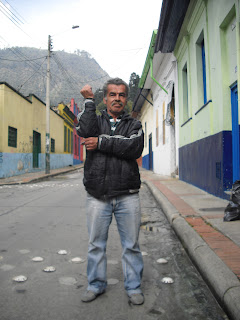If there’s one emotion we’ve come to tame, for the most part anyway, it’s jealousy. Feeling envious of or resenting people because of their status, job, love-life or whatever is something we’ve realised doesn’t get you anywhere.
Yes, there are times we might look at others and think things are going better for them in certain contexts compared to us, but we tend not to let it occupy our minds for too long. To do so would be a waste of good energy.
 |
| The problems start in the mind. |
However, in those very brief moments of envy, we get a feeling of what it must be like to live with jealousy practically all the time. And it is certainly not a nice place to be, mentally speaking.
Yet, from our own experiences and those of many we’ve talked to – both locals and foreigners, men and women – this appears to be a state of mind that a significant number of Colombian women live with on a constant basis (it may exist on the men’s side, but it’s something we don’t notice as much).
Many will accuse us of wild generalising about this. So we must say that, of course, it’s not all Colombian women who have these traits but there certainly does seem to be a higher level of it here compared to other places we know.
Yes, perhaps we’re just noticing such jealousy more in these parts than other countries, but when so many people refer to its routine existence, there must be some ring of truth to it.
Now, if this is an emotion that doesn’t usually affect you, it can be difficult to comprehend why people have such feelings.
Those who do strongly sense it, though, are, from experience, next to impossible to reason with.* No matter what you say to them or hard evidence you provide to contradict their perceptions matters little. Best practice is to just wait for the emotional storm to blow over and make the most of the rare periods of calm.
The type of jealousy we’re specifically referring to is in a relationship/romance context. Indeed, as a good Dutch friend here puts it – one who knows all about this as much as anyone – it’s not just jealousy. It comes in a
package deal along with mistrust and insecurity. All three are intrinsically linked.
 |
| Happy couple (and 'Wrong Way'). |
To give an example, one of our best Colombian female friends, a married woman in her late 20s – somebody we would rate as level-headed and easy-going – openly told us that she doesn’t trust her husband.**
Why? Well, her other-half works in the medical profession and one day she picked up his phone by accident to read a thank-you message from a female relation of a patient he had helped.
A nice gesture we thought, but this was enough to send the affair alarm bells ringing for our friend. An emotional confrontation with her husband followed.
When you’re a doctor who often may have to work long hours, we can only imagine what kind of heat you get and explaining you have to do when you arrive home late to your loved one.
Here’s another over-the-top reaction told to us by an expat who brought his Colombian girlfriend back to Europe for a family wedding. At the reception, a long-standing family friend, an older lady, came over to talk to our buddy. A ‘it’s been ages since I’ve seen you’ kind of chat, normal stuff that happens at weddings.
The fact, though, that our friend's girlfriend wasn’t centre of attention and "her man" was talking to another lady was enough to send the Colombian mildly hysterical. ‘How dare he speak to another woman at a family wedding?’
We could go on with similar anecdotes, but we risk putting our own sanity – and yours – in jeopardy.
When you come from a culture where such extreme mistrust/jealousy/insecurity doesn’t really exist, this kind of behaviour can be mind-blowing. We must state, however, that the old saying that there’s no smoke without fire does come into play among Colombians in this regard (see
http://bit.ly/13VtSAZ for more).
The important question here is which comes first, the unfaithfulness or the jealousy? You see it’s a vicious circle.
There are plenty of infidelity examples and stories going about the place that only serve to raise suspicions for Colombian women at the slightest sign of potential wrongdoing – way off the mark as they may be – from their partner.
So the interrogation begins, which very quickly can turn into wild accusations and, yes, physical abuse. The kitchen sink and its implements are, in many cases quite literally, hurled at the accused.
 |
| There's always Ted. |
Thus, with very little breathing space and a frosty environment, a natural reaction for many men is to look for a break somewhere else. Some can find that by simply downing a few beers with the lads more often than previously.
In this land of plenty, though, when it comes to exceptionally looking women, it can be very hard to resist the overtures of a nice,
friendly lady when your existing relationship has turned into an entrenched battle where you’re always under the cosh.
With that, the usually imaginary smoke that your partner initially smelt and saw becomes real and is given a source. A quintessential self-fulfilling prophecy.
So, you see there are well-being reasons why we haven’t been too bothered to fully commit to a relationship here yet.
_________________
*There are a few posts to choose from here, but a good place to start is
'Colombia's locas'.
**We don't need to explain that trust should be an essential part of any friendship or relationship. For more on that theme see
'Forever friends'.
ESSENTIAL VIEWING! For some Colombian agreement with this post, check out this short, humorous YouTube video (in Spanish, although it's pretty easy to follow without knowing the language):
http://bit.ly/Y5cEL3.


















